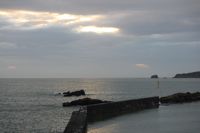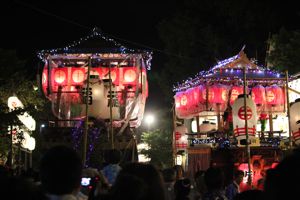
On March 11 of last year a megathrust earthquake 70 kilometers off the coast of Japan triggered a catastrophic tsunami that swept up to ten kilometers inland, devastating the northeast coast of Japan's largest island, Honshu. One year later, nearly 16,000 deaths have been confirmed and over 3,000 people remain missing. The level 7 meltdowns, triggered by the tsunami, at the Fukushima Daiichi Nuclear Power Plant have created a no-man's land between Tokyo and Sendai, the hardest hit major city. The past year saw the detection of radiation "hotspots" outside the evacuation zone and contaminated tap water, beef and other products including, a few months ago, trace amounts of radioactive cesium in infant formula.
I thought for a long time about what I could write to mark the anniversary of this disaster. A piece on some interesting point of Japanese culture seemed too specific for something of this magnitude, but a general piece on the stoic nature and cultural cohesion of the Japanese wouldn't be very different from many other available articles. Eventually, it occurred to me that it would be best to step aside and let some Japanese bloggers do the talking. Of course, unless you are Japanese or an American who fluently reads kanji, getting through their posts will be a slow process. Given that a picture is worth a thousand words and that Japan is arguably the land of cameras, the more visual approach of these Japanese blogs seemed appropriate.
A piece on some interesting point of Japanese culture seemed too specific for something of this magnitude, but a general piece on the stoic nature and cultural cohesion of the Japanese wouldn't be very different from many other available articles. Eventually, it occurred to me that it would be best to step aside and let some Japanese bloggers do the talking. Of course, unless you are Japanese or an American who fluently reads kanji, getting through their posts will be a slow process. Given that a picture is worth a thousand words and that Japan is arguably the land of cameras, the more visual approach of these Japanese blogs seemed appropriate.
Nakano Hajime's blog tells the story of 73 volunteers who last summer traveled north by bus from Tokyo Station to the destroyed town of Rikuzentakata, in Iwate Prefecture. Working with the locals and hand-drawn maps, they assisted in clean up, object recovery and resource distribution. Also shown are a couple local newspaper images, one showing an photo and article about a local summer festival (more on that with the next link) and the other an advertisement for a company that scraps farm equipment, a service aimed at the many people who are leaving the area.
Matsuri are local festivals held in nearly all Japanese municipalities. Although the dates of these celebrations are not uniform, almost every town has one in the late summer, referred to as Natsu-Matsuri (Summer Festival). These affairs are usually accompanied by a procession of elaborate floats, carried or pulled by the local men, glowing with lanterns, and often housing musicians playing traditional instruments. On the top level of the floats children ride through the town, singing along with the songs and banging drums and tin cans to the rhythm. Matsuri is celebrated by everyone, but it is a magical time for the young. While in Japan last summer, my wife and I saw a TV news report of Rikuzentakata celebrating Natsu-Matsuri, the parade winding through the flattened heart of the town. Many of the children were newly orphaned, and the adults who organized the celebration had lost much as well. But like earlier generations who identically rebuilt shrines and castles after the war, some things are not up for compromise. Scroll down to the lower half of the linked page, by the blogger Sinanodaimon (pen name), to see the Natsu-Matsuri procession.
referred to as Natsu-Matsuri (Summer Festival). These affairs are usually accompanied by a procession of elaborate floats, carried or pulled by the local men, glowing with lanterns, and often housing musicians playing traditional instruments. On the top level of the floats children ride through the town, singing along with the songs and banging drums and tin cans to the rhythm. Matsuri is celebrated by everyone, but it is a magical time for the young. While in Japan last summer, my wife and I saw a TV news report of Rikuzentakata celebrating Natsu-Matsuri, the parade winding through the flattened heart of the town. Many of the children were newly orphaned, and the adults who organized the celebration had lost much as well. But like earlier generations who identically rebuilt shrines and castles after the war, some things are not up for compromise. Scroll down to the lower half of the linked page, by the blogger Sinanodaimon (pen name), to see the Natsu-Matsuri procession.

Seeing the Japanese care for each other and refuse to fall into despair always leaves me with hope for their culture and country. The chips are stacked against them right now, economically and demographically. But this is a culture that, in certain important respects, is highly sure of itself and functional. And they definitely don't give up.